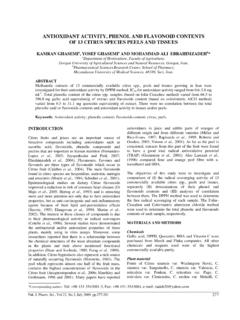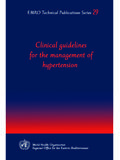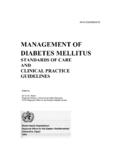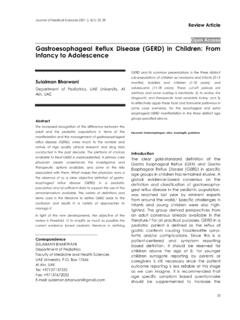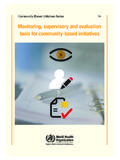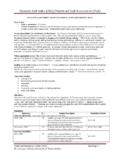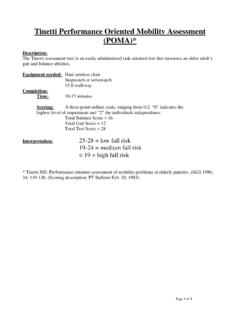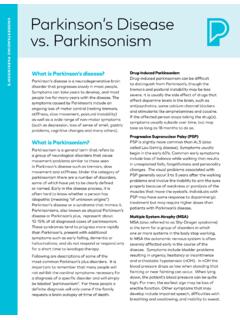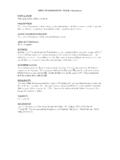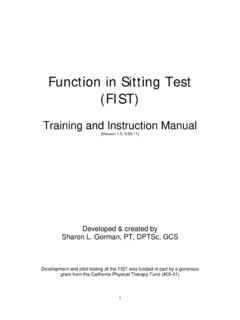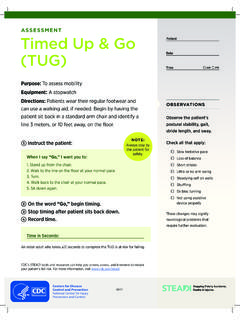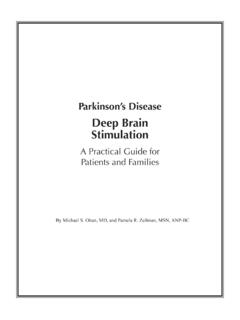Transcription of REHABILITATION OF PARAPLEGIA
1 Vol. 11, -Jan. -June 2008 J. Baqai Med. Univ. REVIEW ARTICLE REHABILITATION OF PARAPLEGIA Farhan Ishaquel, Mahwish Shamim2 ABSTRACT: The term PARAPLEGIA is used to define the loss of ability to move or feel both legs and lower trunk. PARAPLEGIA is usually caused by an injury to the spinal cord at the level of thoracic, lumbar or sacral region, which sequentially results in a loss or damaged function. Injuries resulting from a motor vehicle accident, gunshot and during sports activities may result in PARAPLEGIA . Non-traumatic factors like scoliosis, spinal tumors and spina bifida can also cause PARAPLEGIA . Paraplegic patients have an extensive stage of REHABILITATION ahead. Most important goals for paraplegic REHABILITATION are to increase strength, improve flexibility, increase endurance or aerobic conditioning, gait training, transfer training and improve body positioning.
2 KeyWords: Functional Electrical Stimulation [FES], gait Training, SCI INTRODUCTION PARAPLEGIA is a term used to explain a condition for a person who has been paralysed due to a spinal cord injury. PARAPLEGIA is a Greek word (Para for "two" and Plegia meaning paralysis). It involves loss of movement and sensation in the distal half of the body (right and left legs)l. It usually takes place as a result of spinal cord injuries at Tl or below injury in the thoracic, lumbar or sacral regionl,ll . The spinal cord is a cluster of nerves that transmits messages between the brain and the rest of the body2. A patient of PARAPLEGIA at B aqai Medical University, Hospital Kind of SCI Lesions: It is significant to note that the does not have to be completely cut off for the loss of functionlO,12.
3 <? 70% incomplete lesions, 30% complete lesions5. <? 60% paraplegic lesions, 40% tetraplegic lesions. <? A complete injury indicates that there is no function below the level of the injury; n() ~~Il~~!i()!! and no controlled movement. Both sides of the body are evenly affected. <? An incomplete injury indicates that there is some functioning below the level of the injury. A person with an incomplete injury may be able to move one limb more than another, may be able to feel body parts that cannot be moved, or may have more functioning on one side of the body than the other. <? Such injuries are known as Brown Sequard Syndrome, Central Cord Syndrome, Anterior Cord Syndrome and Posterior Cord Syndrome1,12. 1: Senior Lecturer (BIPTRM), 2: Assistant Professor, Baqai Insti tute of Physical Therapy and REHABILITATION Medicine, Baqai Medical University, Karachi.
4 Vol. 11, -Jan. -June 2008 Diagram showing Level of the Injury A spinal cord injury above this line would result in quadraplegia Posterior (Rear) Anterior (Front) Following are the Common features of PARAPLEGIA : - -Loss of movement, sensation, and reflexes below the level of the spinal cord injury immediately after the spinal cord injury. - -Muscle weakness or paralysis in the legs, trunk or arms. - -Failure of Bowel and Bladder control, depending on where the spinal cord injury occurred. - -Sexual variations - -Muscle spasticity. - -Gastrointestinal problems. REHABILITATION : REHABILITATION is the (re)integration of an individual with a disability into society. This can be done either by enhancing existing capabilities or by providing alternative means .. " (Robinson 1993)[05] Basically REHABILITATION is dependent relatively on the level and type of spinal cord damage.
5 THE REHABILITATION TEAM: The REHABILITATION team facilitates to set short term and long term treatment goals for recovery. Skilled and expert professionals are part of the Paraplegic REHABILITATION team, inclu?ing11: Physiatrist N eurologist/N eurosurgeon Orthopaedic surgeon J. 8aqai Med. Univ. Physical Therapist Occupational Therapist Psychologist/Psychiatrist Orthotist Social Worker Dietician The goals determined for each individual will vary according to the level of injuries. Every injury is only one of its kind and two injuries categorised as the identical level will not always show the same deficit8,11. PHYSICAL THERAPY: o Physical therapy is the most important part of the treatment program in REHABILITATION centers. Physical therapy seeks to bring back or uphold the ability to move.
6 O Physical therapy generally focus on reducing muscle tone, maintaining or improving range of motion and mobility, increasing strength and coordination and improving comfort. 3 o Physical therapy exercises help in maintaining bone density, as the paraplegic patients are more prone to develop osteoporosis in the lower limbs especially in the region of the hip14. o Physical therapy programs may also incorporate treatments designed to prevent> certain complications such as frozen joints, contractures or bedsores. o Therapies may include stretching, strengthening, aerobic exercises, gait training and appropriate use of assistive devices, such as canes, braces, walkers etc. o Balance and coordination activities; transfer training - such as how to get from bed to wheelchair or from wheelchair to car.
7 O Postural changes are also one of the big issues which might result in bed sores and need postural re-education8. o Therapeutic techniques can also include such as hydrotherapy, ultrasound therapy, electrical stimulation which help in stimulation of expiratory muscles and increasing the cross-sectional area of large arteries and enhance blood circulation to the paralyzed legs of individuals with SCI. 22 Balanced Exercise Program: A balanced exercise program includes three types of exerCise: Vol. 11, -Jan. -June 2008 Stretching Exercises: o Stretching is one of the most important exercises and must be done on a regular basis, usually twice a day. That is because stretching improves the ability of muscles to move the parts of body through their full range of motion and release J. Baqai Mec'J.
8 Univ. contracture27. Stretching also reduce muscle spasms and Spasticity. o Every stretch should be performed slowly and gradually for 10 seconds. Some of the important stretching exercises for paraplegics are as follows: Bilateral Adductors Stretching Quadriceps Stretching Vol. 11, -Jan. -June 2008 Aerobic Exercises: Aerobic exercise helps to enhance energy levels, reduce fatigue, and control body weight. It also fortifies heart and lungs and improves body's ability to use oxygen. Early REHABILITATION enhances the cardiac efficiencyI9,9. Exercise training is important for the Paraplegics in the same way as the non-handicapped individuals. Both strength (ability to develop tension) and endurance (aerobic capacity as measured by V02 max) contribute to overall functional capacity. Moreover expiratory muscle training exercise help in improving inspiratory muscle function20.
9 Active exercise gives a positive stimulus to the cardio respiratory system. A combine contraction of upper extremity and of paralysed lower extremity muscles results in activation of more muscle groups7. Strengthening Exercises: Strengthening exercises help in increasing muscle tone and improve the potency of muscles17. Resistance and endurance training enhances mobility and provides a positive sense of well-being29. Strong hip and leg muscles are needed to lift the legs to walk and strong arm muscles are needed to carry out ADLs, especially latissimus dorsi muscle needs to be strengthen adequately to perform the pulling and pushing activities. Strong abdominal and back muscles help J. 8aqai Med. Univ. to maintain correct posture and can respond to the pain resulting from poor gait , poor posture or the use of mobility aids.
10 Patients with spinal cord injury are able to stimulate their trunk muscles, even the muscles below the level of injury2. Therefore physical therapist must concentrate on the strengthening of trunk musculature, which plays a crucial role in gait training. gait TRAINING OF A PARAPLEGIC PATIENT: walking or gait training is the ultimate goal of a paraplegic patient. Along with strengthening and balance exercises, physiotherapists and orthotists recommend certain orthosis, by the help of which a patient can perform their functional tasks not only in standing but also in walkingI8,19. Most commonly knee ankle foot orthosis with pelvic belt (KAFO) is preferred. A swing through type of gait pattern is accomplished with KAFO along with elbow crutches1. walking is recommended according to the ability, endurance and safety of the training also helpful in gait training of paraplegics23.
